 |
| CLOTHING AND EQUIPMENT LISTS FOR REGULAR UNIT IMPRESSIONS . |
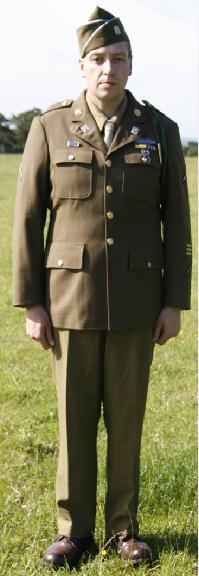 |
 |
| Class A & B Uniforms |
| Cap, Garrison, OD. Sometimes called an overseas cap (after its Great War predecessor) this item of headgear was made in olive drab wool serge, for those occasions where the helmet was not necessary. Early war caps had an expanding box pleat in the top, which are pattern preferred for the D-Day period we depict. To simplify construction and conserve material, the caps were re-designed very later in the war to have a square cut top. The edges of the cap were invariably piped in the colour of branch of service. SHIRT, FLANNEL, OD, COAT STYLE. Like the wool trousers, every GI received two wool shirts. The phrase coat style is because it opened fully at the front � unlike the "pull over" predecessors and had two breast pockets with button down flaps. The shirt came in two types - 'regular' and 'special', the only difference being the special had a gas flap behind the buttons and gussets to protect against vesicant chemicals. Some shirts also have a pair of buttons underneath the collar intended as fastenings for the gas hood. Many soldiers removed the gas flaps as they added thickness and bulk when worn with their Class A & B uniform. TROUSERS, WOOL, SERGE, OD, LIGHT SHADE M1937 On entering the service, every soldier was issued two pairs of wool � or more accurately 18-ounce serge trousers. The trousers have two side seam pockets, a watch pocket on the right front waistband and two rear hip pockets. Because they are made from a lighter shade material than the service coat and, to differentiate them from the darker, later war production runs, they have earned the anachronistic term of "mustards" by collectors. The cut of the wool trousers was improved following combat experience in North Africa, the most notably being the increase of the seat by two inches and the addition of an anti-gas flap across the fly. Later runs had flaps covering the rear pocket opening and button and tab adjusters at the bottom of the leg. Jacket, Field, OD. Prior to 1939, the US Army's intention was to fight in the service coat. However as the clouds of war closed in, the Army decided to search for a more practical garment for fighting in, and which would ultimately consign the service coat to dress occasions. The resulting garment was based on a civilian jacket � it was short olive drab jacket made from windproof, water-repellent cotton poplin with a flannel lining. It had two slash pockets at the front, adjustable cuff and neck closures and had pleats at the shoulder allowing more flexibility. As one might expect, the jacket was not a particularly successful as the poplin material tended to wear out quickly in combat, was hot in summer and cold in winter, lacked a decent pocket capacity, and tended to show up against dark backgrounds. While attempts to improve the garment resulted in the M1943 combat jacket, such quantities had been produced that these were the most common jacket until well into 1945. Collectors anachronistically call these jackets as M41 (after the pattern date) to differentiate them from the later M43 pattern. The real GIs, untutored in designs, patterns and model numbers simply call them.... field jackets. Coat, Wool, Serge, OD. This was the standard dress uniform of the GI until late 1944 when it was replaced by the �Ike Jacket�. Anachronistically known by collectors as a �four pocket�, it was intended to be the Army�s combat jacket, imitating its Great War forerunners, until the introduction of the field jacket in 1941, relegated its use to ceremonial and dress use. Accordingly, the design of the coat changed slightly as the war progressed to reflect its new use, as well as save materials and simplify production. First, was the omission of brass support hooks for the garrison belt when that was obviated, followed by the removal of the bi-swing back in late 1942. As stated, the wool service coat was declared limited standard in November 1944, when the Ike Jacket (which ironically was proposed as the new US army fighting uniform) replaced it. Arguments within the quartermaster about its use compromised with its implementation as a liner to the M-1943 combat jacket. Being waist length, the Ike jacket conserved material and was washable, however, most soldiers felt the Ike jacket was impractical in combat and invariably saved it for use as a form of dress uniform. Drawers, Cotton, Shorts, OD. According to the table of issue, every GI received five pairs of under shorts. Early in the war, they were white, but as the war progressed, and interests of camouflage, they were produced in olive drab colour. They had three buttons at the waistband and had -in lieu of elastic � tie fasteners for final adjustment. While un-issued and reproduction underwear is available (and surprisingly comfortable) this is one area of authenticity we leave to the individual's conscience! Undershirt, Cotton, Summer, Sleeveless, OD. Like the under shorts, each GI was issued five singlets. These too, were initially white at the start of the war, but due to camouflage reasons, production was changed to olive drab cotton. Original undershirts are available � as are very good reproductions and, like the GI under shorts, the choice between original and reproduction is left to the individual's scruples. Socks, Wool, Cushion Sole, OD. There were two types of socks for the infantryman � cotton and wool � and every soldier was issued three pairs of each. While original socks are available, modern military examples are acceptable and, longer lasting. Necktie, Cotton, Mohair, Khaki With the adoption of the open necked service coat, the US Army adopted a black cotton tie for formal functions, however by 1940 this had become black mohair which, by 1942 had become substituted for a light olive drab mohair finish. Photographic evidence suggests ties were never worn in combat although General Patton was insistent that all soldiers in the 3d Army carried their ties and fines were issued for soldiers that refused to wear them. One presumes his logic is that would smarten the troops up � or give them a potential tourniquet. Fortunately, after Sicily, the 1st Division and Patton seldom worked together. Belt, Web, Waist, EM, M-1937 Every soldier was issued one of these trouser belts. At 1 1/4 inch width, the belt had a metal tip and an "open face" buckle, which is a design still in service today. While "Closed face buckles", akin to those worn by officers, were sold at the PX, we insist on the "open face" type, which was more typical of the type issued to the enlisted man. Shoes, Service, Composition Sole . The Army approached World War II with the Type I service shoe - an ankle height, �chromed�, brown leather boot - with a toe cap and plain leather sole. It quickly became clear that the service shoe�s soles quickly wore out and, consequently, were unlikely to withstand the punishment of combat. The solution was the unimaginatively titled �Type II� service shoe, which featured a composite rubber tap (sole) and heel. In mid-1943, combat experience revealed areas for design change, resulting in the creation of the Type III service shoe. Anachronistically called �rough-outs� by collectors to describe their appearance, they were constructed with the flesh side of the leather on the outside of the shoe, which was easier to break in, more comfortable and, in theory, capable of absorbing dubbing and gas proofing pastes more easily. Unfortunately, the shoe tended to absorb water equally well. This problem would also afflict the M-1943 combat boot, which used the Type III as the basis of its construction. Overcoat, Wool, Melton, OD, Roll Collar, 32-oz. The overcoat was a double-breasted wool garment with two slash side pockets, epaulettes and a buttoned half-belt in the back that could be loosened to allow the wearer greater manoeuvrability. It originally had brass buttons, but in 1942, the buttons were replaced with plastic to conserve materials. While it was very smart, unfortunately, it wasn�t particularly effective as a combat garment, being stiff, tight fitting and heavy (especially when wet) while the length of the coat tended to impede movement when marching or fighting. As such, it was to be replaced by the �layering� system of the M-1943 combat uniform and consequently was relegated to use with the service uniform and formal dress. However, shortfalls in the production of the M-1943 combat uniform and lack of warm clothing meant that stocks of overcoats had to be rushed to Europe for the winter campaign. |
| Garrison Uniform |
| Service Uniform |
| Insignia for the Service Uniform |
| Each of the various arms and services of the Army of the United States has its own distinctive marks and insignia. These were worn to aid unit recognition and to breed and esprit de corps among the men. The insignia authorised for wear upon the Winter Service Coat has been defined with the following in mind
� That the insignia reflect the adopted identity of the unit � That the insignia reflect the honours awarded to that unit circa June 1944 � That the insignia in no way implies that the individual has engaged in combat or that the individual has awards for wounds or for valorous conduct. This third criteria is especially important as the unit feels that it would he dishonourable to veterans to wear such awards ARM OF SERVICE INSIGNIA The HAT CORD. The colour of the hat cord is used to distinguish the arm of service to which a soldier belongs. For the infantry the colour is Sky Blue. The 'cord' is worn as piping around the Garrison Cap. We base our displays on the soldier of the 16th Infantry Regiment before D-Day. While we wear insignia pertinent to the unit at that time � unit citations, fourrag�re, rank insignia, etc, we do not wear Combat Infantry Badges or awards for valour. Our only concession to authenticity is the wearing of a single regimental crest on our garrison caps as marks of recognition and respect to the men of the 16th Regiment. |
| Metal INSIGNIA. Two brass discs worn upon the upper lapel of the Service Coat also serve to indicate ARM of service. One disc shows "U.S." for the regular army, the other depicts a pair of crossed rifles to designate infantry. DISTINCTIVE INSIGNIA. Each regiment has a heraldic crest, which describes its heritage and ancestry. The 16th Infantry�s crest was approved in 1926 and has a background of blue and white �vair�, taken from the mediaeval coat of arms for the town of Fleville, which the unit captured in WWI. The crossed arrow and bolo represents the unit�s involvement in the Indian wars and suppression of the Philippine insurrection respectively. At the centre bottom is a representation of a five bastioned fort, which the unit adopted from the badge of the Fifth Corp whilst serving under them in Cuba. The regimental crests were to be worn on the garrison cap and both lapels of the service coat; however, this peacetime �nicety� fell by the wayside, presumably to free industry and materials for more productive contributions to the war effort. At the end of hostilities, the tradition of regimental crests resumed, with German companies being used to meet initial demand. We allow one crest to be worn on the garrison cap as a mark of recognition and respect to the men we represent. This is our only permitted concession to authenticity. |
 |
| 1ST DIVISION SHOULDER INSIGNIA. This is the Divisional Patch, Located on the upper part of the outer half of the left sleeve of the service coat. It was also authorised to be worn on the overcoat, field jacket and shirt (when worn as an outer garment). The top of the patch was to be 1/2 inch below top of the shoulder seam. |
 |
| FOURAGERRE This was awarded to the regiment by the French government for its service during World War One. All members of the regiment are authorised to wear it looped upon the left shoulder, as per regulation. It consists of a single cord, braided and knotted, of dark green and scarlet threads terminated at the shoulder end with a buttonhole and at the free end by a ferret of metal.. |
 |
| PRESIDENTIAL UNIT CITATION. This represents the citation awarded to both the 1st and 2nd Battalions for the Sicily campaign of July/August 1943. The device is a blue ribbon set in a gold coloured metal frame of laurel leaves. It is worn above the right breast pocket centred over the flap button |
 |
| BADGE FOR QUALIFICATION IN THE OPERATION OF VEHICLES
Issued in recognition of qualification to operate vehicles of different types. The type of vehicle is indicated by a bar attached below the badge. For example Driver � W. The badge when worn on its own is place in a similar manner to the weapons qualification badge. When worn in addition to the weapons qualification badge it is pinned to the left breast pocket flap centred between the right edge and the button. |
 |
| BADGE FOR QUALIFICATION IN THE USE OF ARMS Issued as a Result of qualification in weapons designated as the principle arm. The weapon is indicated by a bar attached below the badge. The badge is attached to the left breast pocket flat, above and centred upon the button. It is worn centred between the left edge of the pocket flap and the button if worn in combination with the drivers' badge. Rifle, Machinegun, B.A.R, Pistol, Grenade, Carbine, Bayonet, Flamethrower |
| AMERICAN DEFENCE SERVICE MEDAL Issued to military personnel on ACTIVE federal service of 12 months or longer and who in discharge of such service served at ANY time between September 8d 1939, and December 7th 1941. Ribbon: Yellow with narrow red white and blue stripes near the edge. The ribbon is worn on the left breast, above the pocket nearest the collar AMERICAN THEATRE CAMPAIGN MEDAL For service in WWII OUTSIDE the continental United States. Ribbon: Blue with narrow red white combination of narrow black and white stripes representing Germany, and narrow red and white stripes representing Japan. near each end. The ribbon is worn above the left breast pocket next to the American Defence Service Medal. EUROPEAN-AFRICAN-MIDDLE EASTERN CAMPAIGN MEDAL The European-African-Middle Eastern (EAME) Campaign Medal was awarded to personnel for service within the European-African-Middle Eastern Theater between 7 December 1941 and 8 November 1945 under any of the following conditions: (1) On permanent assignment. (2) In a passenger status or on temporary duty for 30 consecutive days or 60 days not consecutive. (3) In active combat against the enemy and was awarded a combat decoration or furnished a certificate by the commanding general of a corps, higher unit, or independent force that he actually participated in combat. |
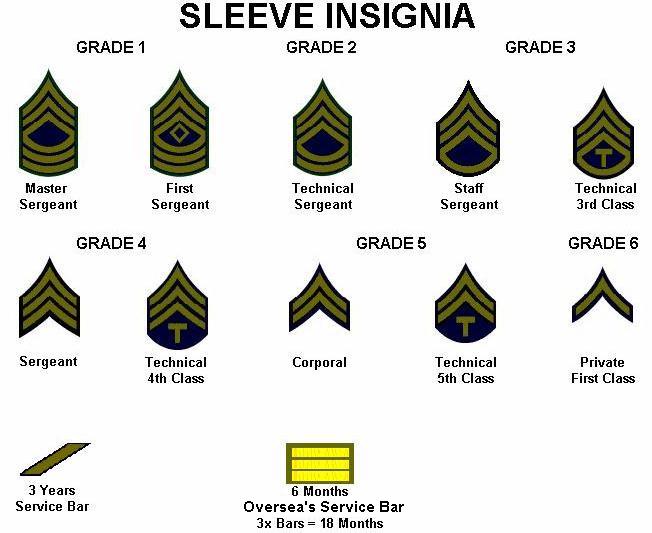 |
 |
 |
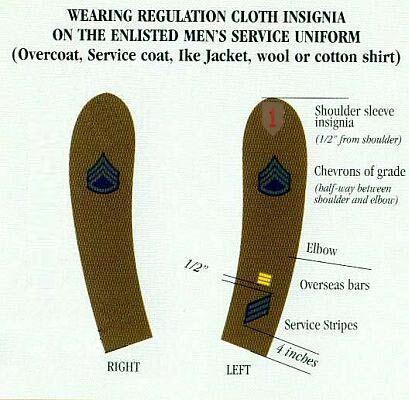 |
| M1942 US Army Herringbone Twill (HBT) Fatigues |
| US Army Herringbone Twill (HBT) Fatigues
Every soldier was issued with two sets of this utilitarian work uniform. There were two patterns of fatigue; the first type was the 1941 type, which was a light, sage green colour and had two small chest pockets with an adjustable waist band. The trousers were made of the same cotton material, and were cut identically to the OD wool trousers. While it wasn�t intended to be a combat uniform, the cooler cotton fabric and more spacious cut meant they were often used to substitute the heavier, OD wool uniform in warm and tropical climates. As the prevalence of fatigues in combat increased, they were re-tailored accordingly. The resulting 1943 pattern was simpler in construction, included a gas flap and featured two large cargo pockets on the chest and both hips of the trousers. Regrettably, they were also made in the light shade material, which had the disadvantage in that it tended to bleach with repeated washing. This was a tactical concern as from a distance it tended to resemble the German fatigue uniform and stood out against dark backgrounds or at night. To get around this, in mid-1943, the army adopted a much darker shade material (OD#7). However, stockpiles of uniforms meant both shades of uniform continued to be issued and mixes of fatigue patterns and shades were common place. |
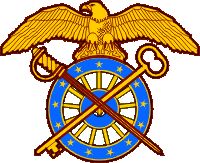 |
 |
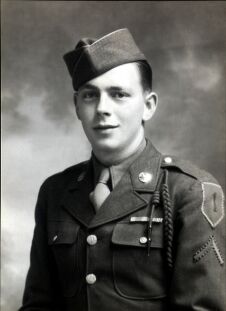 |